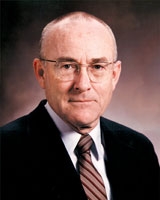Henry McGill, Jr., MD
Born: 1921

Henry McGill was educated at Vanderbilt and received his MD there in 1946. Working with the charismatic Russell Holman at LSU in the late 1940s, they began addressing questions about childhood atherosclerosis by systematically grading arteries in pediatric autopsies at Charity Hospital of New Orleans. Through Nevin Scrimshaw in Guatemala, they soon began looking at cultural differences in the frequency of “fatty streaks,” which they had begun to suspect were the Anlage of the fibrotic plaques of adults. On Sabbatical in South America, in part due to his Methodist missionary affinity, McGill had an epiphany: “One afternoon I woke up from a nap with the idea that we ought to do this kind of survey right. We ought to organize and study and collect arteries. A lot of different places recording with standardized methods, and just do it right!” Thus began the classic International Atherosclerosis Project (IAP) that they called geographic pathology, not epidemiology. The projects first epidemiological consultant was Jerry Morris of London.
The IAP went on to establish many basic concepts about atherosclerosis, that the fatty streak was ubiquitous and comparably prevalent in young children across cultures, that the frequency of organized plaques coincided with what was known about the prevalence of adult clinical disease, and that the fatty streaks were the site of origin of complex lesions.
In the 1960s, McGill became Chair of Pathology at the University of Texas Medical School at San Antonio and then in 1972 started the Department of Physiology and Medicine at the Southwest Foundation for Biomedical Research (SFBR), serving as its first Chairman and later as SFBR’s first Scientific Director. He established the baboon colony at the institute because of the similarity of its experimental disease to that of humans, and a particular breeding program has provided an animal model for the study of many other human diseases, including obesity and diabetes and mental illness.
In recent years, Dr. McGill joined with Robert Wissler in developing PDAY, a collaborative study of the origins and progression of atherosclerosis in youth that uses advanced molecular techniques and has pioneered new understanding of the role of genetic and cultural influences on the process. This, in turn, has contributed to ongoing practice and policy for initiation of CVD prevention in youth.
Dr. McGill remains highly productive in unretired retirement at Southwest Institute. (HB)
Sources
McGill, Henry (1968). The Geographic Pathology of Atherosclerosis. Baltimore: Williams & Wilkins Co.
McGill HC Jr, McMahan CA, Zieske AW, Sloop GD, Walcott JV, Troxclair DA, Malcom GT, Tracy RE, Oalmann MC, Strong JP (2000). Associations of coronary heart disease risk factors with the intermediate lesion of atherosclerosis in youth. The Pathobiological Determinants of Atherosclerosis in Youth (PDAY) Research Group.
Arterioscler Thromb Vasc Biol., 20, 1998-2004.
Interview with Darwin Labarthe, March 21, 2001.